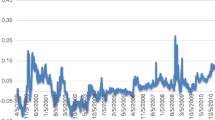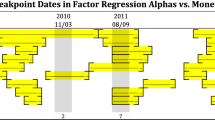Abstract
In seeming contradiction of the efficient markets hypothesis, closed-end fund shares typically trade at discounts to their portfolio values. We find that about half of these discounts are nonstationary. Focusing only on those funds that have stationary discounts, this study applies the Bai and Perron (1998, 2003a,b) methodology to test for structural breaks in the mean discounts. Virtually all have structural breaks, and our findings contradict previous studies that indicate closed-end fund discounts revert to a long-term mean value. The data indicate that closed-end fund trading strategies are more risky than they superficially appear. As structural breaks in mean discounts do not occur together, our analysis does not find support for a common factor (possibly investor sentiment) causing these breaks.
Similar content being viewed by others
References
Anderson, S.C. 1986. “Closed-End Funds Versus Market Efficiency.”Journal of Portfolio Management 13: 50–55.
Anderson, S.C., B.J. Coleman, and J.A. Born. 2001. “A Closer Look at Trading Strategies for U.S. Equity Closed-End Investment Companies.”Financial Services Review 10: 237–248.
Bai, J. and P. Perron. 1998. “Estimating and Testing Linear Models with Multiple Structural Changes.”Econometrica 66: 47–68.
Bai, J. and P. Perron. 2003a. “Computation and Analysis of Multiple Structural Change Models.”Journal of Applied Econometrics 18: 1–22.
Bai, J. and P. Perron. 2003b. “Critical Values in Multiple Structural Change Tests.”Econometrics Journal 6: 72–78.
Bai, J. and P. Perron. 2004. “Multiple Structural Change Models: A Simulation Study.” InEconometric Essays, edited by D. Corbea, S. Durlauf, and B.E. Hansen. Cambridge Univ. Press.
Brauer, G.A. and E.C. Chang. 1990. “Return Seasonality In Stocks and Their Underlying Assets: Tax-Loss Selling Versus Information Explanations.”Review of Financial Studies 3: 255–280.
Brown, G.W. 1999. “Volatility, Sentiment, and Noise Traders.”Financial Analysts Journal 55: 82–90.
Brown, G.W. and M.T. Cliff. 2004. “Investor Sentiment and the Near-Term Stock Market.”Journal of Empirical Finance 11: 1–27.
Cakici, N., A. Tessitore, and N. Usmen. 2000. “Closed-End Equity Funds: Betting on Discounts and Premiums.”Journal of Investing 9: 83–92.
Cakici, N., A. Tessitore, and N. Usmen. 2002. “Closed-End Funds and Turnover Restrictions.”Financial Analysts Journal 58: 74–81.
Chen, N., R. Kan, and M.H. Miller. 1993. “Are the Discounts on Closed-End Funds a Sentiment Index?”Journal of Finance 48: 795–800.
Chopra, N., C.M.C. Lee, A. Shleifer, and R.H. Thaler. 1993. “Yes, Discounts on Closed-End Funds are a Sentiment Index.”Journal of Finance 48: 801–808.
De Long, J.B., A. Shleifer, L.H. Summers, and R.J. Waldmann. 1990. “Noise Trader Risk in Financial Markets.”Journal of Political Economy 98: 703–738.
Elton, E.J., M.j. Gruber, and J.A. Busse. 1998. “Do Investors Care About Sentiment?”Journal of Business 71: 477–500.
Gasbarro, D., R.D. Johnson, and J.K. Zumwalt. 2003. “Evidence on the Mean-Reverting Tendencies of Closed-End Fund Discounts.”The Financial Review 38: 273–291.
Gemmill, G. and D.C. Thomas. 2002. “Noise Trading, Costly Arbitrage, and Asset Prices: Evidence from Closed-End Funds.”Journal of Finance 57: 2571–2594.
Hughen, J.C., and C.G. McDonald. 2005. “Who are the Noise Traders?”Journal of Financial Research 28: 281–298.
Johansen, S. 1988. “Statistical Analysis of Cointegrating Vectors.”Journal of Economic Dynamics and Control 12: 231–254.
Leonard, D.C. and D.M. Shull. 1996. “Investor Sentiment and the Closed-End Fund Evidence: Impact of the January Effect.”Quarterly Review of Economics and Finance 36: 117–26.
Lee, C.M.C., A. Shleifer, and R.H. Thaler. 1991. “Investor Sentiment and the Closed-End Fund Puzzle.”Journal of Finance 46: 75–109.
Malkiel, B. 1977. “The Valuation of Closed-End Investment-Company Shares.”Journal of Finance 32: 847–859.
Ng, S. and P. Perron. 2001. “Unit Lag Length Selection and the Construction of Unit Root Tests with Good Size and Power.”Econometrica 69: 1519–1554.
Pontiff, J. 1995. “Closed-End Fund Premia and Returns: Implication for Financial Market Equilibrium.”Journal of Financial Economics 37: 341–70.
Rapach, D., and M.E. Wohar. 2005. “Regime Changes in International Real Interest Rates: Are They a Monetary Phenomenon?”Journal of Money, Credit and Banking 37: 887–906.
Richards, R.M., D.R. Fraser, and J.C. Groth. 1980. “Winning Strategies for Closed-End Funds.”Journal of Portfolio Management 7: 50–55.
Sias, R.W. 1997. “Optimum Trading Strategies for Closed-End Funds.”Journal of Investing 6: 54–61.
Swaminathan, B. 1996. “Time-Varying Expected Small Firm Returns and Closed-End Fund Discounts.”Review of Financial Studies 9: 845–887.
Thompson, R. 1978. “The Information Content of Discounts and Premiums on Closed-End Fund Shares.”Journal of Financial Economics 6: 151–86.
Wang, Y., A. Keswani, and S.J. Taylor. 2004. “The Relationships Between Sentiment, Returns, and Volatility.”Working Paper (Lancaster University, Lancaster, U.K.).
Weiss, K. 1989. “The Post-Offering Price Performance of Closed-End Funds.”Financial Management 18: 57–67.
Author information
Authors and Affiliations
Corresponding author
Additional information
The results reported in this paper were generated using GAUSS 3.6.
Rights and permissions
About this article
Cite this article
Hughen, J.C., Wohar, M.E. Identifying regime changes in closed-end fund discounts. J Econ Finan 30, 115–132 (2006). https://doi.org/10.1007/BF02834279
Issue Date:
DOI: https://doi.org/10.1007/BF02834279




